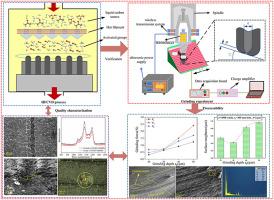Experimental research on the performance of micro-textured CVD diamond-coated abrasive tools in longitudinal-torsional ultrasonic grinding of die steel
IF 3.7
2区 工程技术
Q2 ENGINEERING, MANUFACTURING
Precision Engineering-Journal of the International Societies for Precision Engineering and Nanotechnology
Pub Date : 2025-09-03
DOI:10.1016/j.precisioneng.2025.09.001
引用次数: 0
Abstract
Precision grinding employs the micro-cutting action of abrasive micro-edges to achieve high accuracy and low roughness in machined surfaces. However, the extremely high hardness and wear resistance of diamond abrasive grains present a significant challenge in generating micro-cutting edges on the surface through grinding wheel dressing. Therefore, diamond abrasive tools with micro-edges were prepared by the hot filament chemical vapor deposition (HFCVD) method in this paper. Firstly, the cemented carbide was pretreated, that is, Square and concentric circles micro-textures were prepared on the surface of the cemented carbide by laser technology. Secondly, the concentric circle groove micro-texture boron-doped micro-nano (CCGMT-BDMN) and square groove micro-textured boron-doped micro-nano (SGMT-BDMN) diamond abrasive tools were prepared by HFCVD. The surface morphology, quality and adhesion strength of the textured diamond films were characterized by scanning electron microscopy (SEM), Raman spectroscopy and Rockwell hardness tester. Results indicate incomplete filling of the groove textures with diamond particles, leading to sloping sidewalls at the texture edges. The coating exhibited significant residual stress, which diminished away from the texture edge. Micro-texturing with square grooves enhanced outer edge diamond quality and bond strength, resulting in superior adhesion of SGMT-BDMN abrasive tools. Longitudinal-torsional ultrasonic vibration-assisted grinding (LTUVAG) was evaluated to mitigate diffusion wear between diamond and die steel. Compared to conventional grinding (CG), LTUVAG achieves circumferential intermittent cutting, which reduces grinding forces, suppresses carbon atom diffusion wear on the abrasive tool surface, significantly minimizes adhesive wear, and extends the service life of diamond abrasive tools. Furthermore, the impact of various processing parameters on surface quality was examined. Within specific ranges, enhancing ultrasonic amplitude and grinding speed, while reducing feed speed, positively influences surface quality improvement.

微织构CVD金刚石涂层磨具在模型钢纵扭超声磨削中的性能试验研究
精密磨削是利用磨料微刃的微切削作用来实现加工表面的高精度和低粗糙度。然而,金刚石磨料颗粒极高的硬度和耐磨性给通过砂轮修整在表面产生微切削刃带来了很大的挑战。因此,本文采用热丝化学气相沉积(HFCVD)方法制备了具有微边缘的金刚石磨具。首先对硬质合金进行预处理,即利用激光技术在硬质合金表面制备方形和同心圆微织构;其次,采用HFCVD法制备了同心圆槽微织构掺硼微纳(CCGMT-BDMN)和方槽微织构掺硼微纳(SGMT-BDMN)金刚石磨具。采用扫描电镜(SEM)、拉曼光谱(Raman spectroscopy)和洛氏硬度计(Rockwell hardness tester)对织构金刚石膜的表面形貌、质量和粘附强度进行了表征。结果表明,金刚石颗粒未完全填充凹槽纹理,导致纹理边缘侧壁倾斜。涂层表现出明显的残余应力,残余应力在织构边缘处逐渐减小。方形凹槽的微织化提高了外缘金刚石质量和结合强度,使SGMT-BDMN磨具具有优异的附着力。研究了超声纵扭振动辅助磨削(LTUVAG)对金刚石与模型钢扩散磨损的影响。与传统磨削(CG)相比,LTUVAG实现了周向间歇切削,减小了磨削力,抑制了磨具表面碳原子扩散磨损,显著降低了粘着磨损,延长了金刚石磨具的使用寿命。研究了各种工艺参数对表面质量的影响。在一定范围内,提高超声振幅和磨削速度,降低进给速度,对表面质量的改善有积极的影响。
本文章由计算机程序翻译,如有差异,请以英文原文为准。
求助全文
约1分钟内获得全文
求助全文
来源期刊
CiteScore
7.40
自引率
5.60%
发文量
177
审稿时长
46 days
期刊介绍:
Precision Engineering - Journal of the International Societies for Precision Engineering and Nanotechnology is devoted to the multidisciplinary study and practice of high accuracy engineering, metrology, and manufacturing. The journal takes an integrated approach to all subjects related to research, design, manufacture, performance validation, and application of high precision machines, instruments, and components, including fundamental and applied research and development in manufacturing processes, fabrication technology, and advanced measurement science. The scope includes precision-engineered systems and supporting metrology over the full range of length scales, from atom-based nanotechnology and advanced lithographic technology to large-scale systems, including optical and radio telescopes and macrometrology.

 求助内容:
求助内容: 应助结果提醒方式:
应助结果提醒方式:


